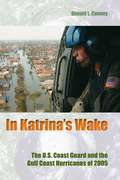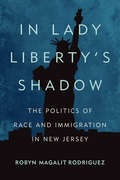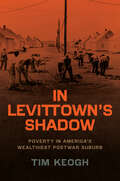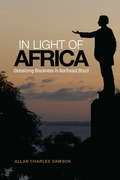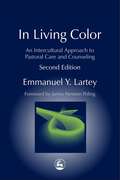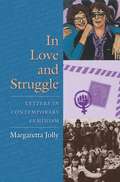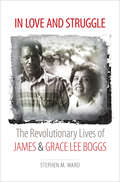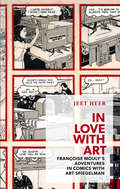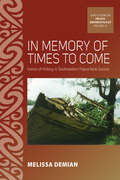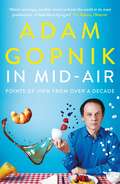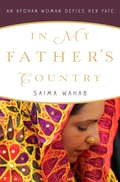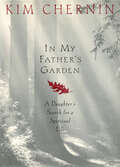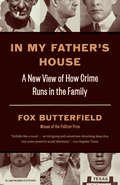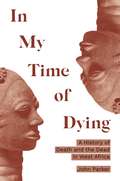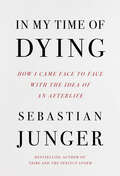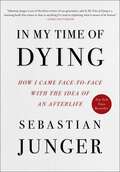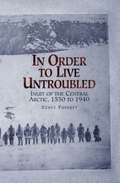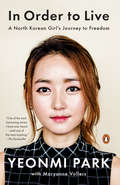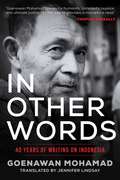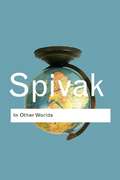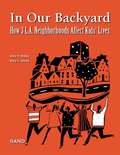- Table View
- List View
In Katrina's Wake: The U.S. Coast Guard and the Gulf Coast Hurricanes of 2005 (New Perspectives on Maritime History and Nautical Archaeology)
by Donald L CanneyOf all the Homeland Security agencies operating in New Orleans before, during, and after Hurricane Katrina’s landfall, no agency performed its duties with the same level of diligence and heroism as did the U.S. Coast Guard. Tirelessly, Coasties in helicopters and small boats pulled survivors from rooftops, floating debris, and high ground and ferried them to safety as the rest of us watched live on CNN.Only a few days later, disaster struck again in the form of Hurricane Rita, which left even more people in desperate need of rescue and assistance. In the aftermath of the storms, some 5,000 Coast Guard personnel rescued 33,735 individuals--six times more than the annual average number rescued by the service nationwide. Then, unobserved by the media, the Coast Guard successfully restored the vital navigation aids in the region, preventing further death and destruction.In Katrina’s Wake presents a riveting account of the astounding operations undertaken by the men and women of the U.S. Coast Guard in the aftermath of one of the worst natural disasters ever to strike America. While other government agencies struggled to mobilize and failed to provide real solutions, one small, decentralized agency stepped forward and performed above and beyond the call of duty.
In Krisen aus Krisen lernen: Sozioökonomische Bildung und Wissenschaft im Kontext sozial-ökologischer Transformation (Sozioökonomische Bildung und Wissenschaft)
by Reinhold Hedtke Lisa-Marie Schröder Harald Hantke Theresa SteffestunDas zu Beginn der Corona-Krise heraufbeschworene „neue Normal“ wird von Krisen geprägt sein. Schon früher traten miteinander verwobene Krisen wie die Finanz- und Wirtschaftskrise 2007 ff., die Staatsschulden- und Eurokrise 2010, Armutskrisen oder die Krisen der liberalen Demokratie, etwa durch den Rechtspopulismus, zutage. Die Pandemie ist allgegenwärtig, das Klima bildet den Inbegriff einer Dauerkrise, die weitere Krisen evozieren wird. Die Omnipräsenz von Krisen fordert die Gesellschaft heraus.Dieser Themenband widmet sich dem Umgang mit Krisen aus der Perspektive sozioökonomischer Bildung und Wissenschaft. Ausgehend von den Erfahrungen des Lehrens und Lernens in Krisen erörtern die Beiträge u. a. folgende Fragen: Welche Bildungsinhalte, -formen und -politiken helfen, um in Krisen aus Krisen zu lernen? Welche Wege zum Umgang mit dem Dauerkrisenzustand bietet die sozioökonomische Wissenschaft? Neben programmatischen, theoretischen und historischen Abhandlungen stellt der Band Lehr-Lernformate dar, die diese Herausforderung angenommen haben. Präsentiert werden fachdidaktische und fachwissenschaftliche Antworten auf multiple Krisen als Inspiration für Ansätze und Aktivitäten einer kritisch-transformativen sozioökonomischen Bildung und Wissenschaft.
In Lady Liberty's Shadow: The Politics of Race and Immigration in New Jersey
by Robyn Magalit RodriguezHome to Ellis Island, New Jersey has been the first stop for many immigrant groups for well over a century. Yet in this highly diverse state, some of the most anti-immigrant policies in the nation are being tested. American suburbs are home to increasing numbers of first and second-generation immigrants who may actually be bypassing the city to settle directly into the neighborhoods that their predecessors have already begun to plant roots in—a trajectory that leads to nativist ordinances and other forms of xenophobia. In Lady Liberty’s Shadow examines popular white perceptions of danger represented by immigrants and their children, as well the specter that lurks at the edges of suburbs in the shape of black and Latino urban underclasses and the ever more nebulous hazard of (presumed-Islamic) terrorism that threatening to undermine “life as we know it.” Robyn Magalit Rodriguez explores the impact of anti-immigrant municipal ordinances on a range of immigrant groups living in varied suburban communities, from undocumented Latinos in predominantly white suburbs to long-established Asian immigrants in “majority-minority” suburbs. The “American Dream” that suburban life is supposed to represent is shown to rest on a racialized, segregated social order meant to be enjoyed only by whites. Although it is a case study of New Jersey, In Lady Liberty’s Shadow offers crucial insights that can shed fresh light on the national immigration debate.
In Levittown’s Shadow: Poverty in America’s Wealthiest Postwar Suburb
by Tim KeoghNamed one of the best nonfiction books of 2023 by Publishers Weekly! There is a familiar narrative about American suburbs: after 1945, white residents left cities for leafy, affluent subdivisions and the prosperity they seemed to embody. In Levittown’s Shadow tells us there’s more to this story, offering an eye-opening account of diverse, poor residents living and working in those same neighborhoods. Tim Keogh shows how public policies produced both suburban plenty and deprivation—and why ignoring suburban poverty doomed efforts to reduce inequality. Keogh focuses on the suburbs of Long Island, home to Levittown, often considered the archetypal suburb. Here military contracts subsidized well-paid employment welding airplanes or filing paperwork, while weak labor laws impoverished suburbanites who mowed lawns, built houses, scrubbed kitchen floors, and stocked supermarket shelves. Federal mortgage programs helped some families buy orderly single-family homes and enter the middle class but also underwrote landlord efforts to cram poor families into suburban attics, basements, and sheds. Keogh explores how policymakers ignored suburban inequality, addressing housing segregation between cities and suburbs rather than suburbanites’ demands for decent jobs, housing, and schools. By turning our attention to the suburban poor, Keogh reveals poverty wasn’t just an urban problem but a suburban one, too. In Levittown’s Shadow deepens our understanding of suburbia’s history—and points us toward more effective ways to combat poverty today.
In Levittown’s Shadow: Poverty in America’s Wealthiest Postwar Suburb (Historical Studies of Urban America)
by Tim KeoghHighlights how low-wage residents have struggled to live and work in a place usually thought of as affluent: suburbia. There is a familiar narrative about American suburbs: after 1945, white residents left cities for leafy, affluent subdivisions and the prosperity they seemed to embody. In Levittown’s Shadow tells us there’s more to this story, offering an eye-opening account of diverse, poor residents living and working in those same neighborhoods. Tim Keogh shows how public policies produced both suburban plenty and deprivation—and why ignoring suburban poverty doomed efforts to reduce inequality. Keogh focuses on the suburbs of Long Island, home to Levittown, often considered the archetypal suburb. Here military contracts subsidized well-paid employment welding airplanes or filing paperwork, while weak labor laws impoverished suburbanites who mowed lawns, built houses, scrubbed kitchen floors, and stocked supermarket shelves. Federal mortgage programs helped some families buy orderly single-family homes and enter the middle class but also underwrote landlord efforts to cram poor families into suburban attics, basements, and sheds. Keogh explores how policymakers ignored suburban inequality, addressing housing segregation between cities and suburbs rather than suburbanites’ demands for decent jobs, housing, and schools. By turning our attention to the suburban poor, Keogh reveals poverty wasn’t just an urban problem but a suburban one, too. In Levittown’s Shadow deepens our understanding of suburbia’s history—and points us toward more effective ways to combat poverty today.
In Light of Africa
by Allan Charles DawsonIn Light of Africa explores how the idea of Africa as a real place, an imagined homeland, and a metaphor for Black identity is used in the cultural politics of the Brazilian state of Bahia. In the book, Allan Charles Dawson argues that Africa, as both a symbol and a geographical and historical place, is vital to understanding the wide range of identities and ideas about racial consciousness that exist in Bahia's Afro-Brazilian communities.In his ethnographic research Dawson follows the idea of "Africa" from the city of Salvador to the West African coast and back to the hinterlands of the Bahian interior. Along the way, he encounters West African entrepreneurs, Afrobeat musicians, devotees of the Afro-Brazilian religion Candomblé, professors of the Yoruba language, and hardscrabble farmers and ranchers, each of whom engages with the "idea of Africa" in their own personal way.
In Living Color: An Intercultural Approach to Pastoral Care and Counseling Second Edition
by Emmanuel Y LarteyThe meaning of pastoral care in modern multicultural societies is challenged and reexamined from a pluralistic, global perspective in this book. Emmanuel Lartey stresses the importance of recognizing different cultural influences on individuals in order to effectively counsel, guide and empower them. He provides a clear and concise history of pastoral care and considers its relationship to different models of counseling and spirituality. This new edition has been updated to reflect postmodern and postcolonial studies and provides illustrations of how an intercultural approach can work in practice. Theological teachers and students will welcome its return as an indispensable introduction to the field of pastoral care. In Living Color is an essential source of inspiration to leaders from any religious stream who wish to provide pastoral care in a way that reflects their community's cultural diversity. This book is also a useful resource for practitioners in a wider range of caring contexts who work in multicultural environments.
In Love and Struggle: Letters in Contemporary Feminism
by Margaretta JollyMargaretta Jolly provides the first cultural study of women's letters during the 1970s and 1980s, tracing the evolution of feminist political consciousness from the height of the women's movement to today's global networks. Jolly makes sense of the contradictory emotions of letter writing and captures a fragile yet persistent ideal of care, women's love, and epistolary art. From lesbian love letters to dispatches from women's encampments at Greenham Common and the Fourth World Conference on Women in Beijing, from letters exchanged between mothers and daughters to the spread of feminist internet communities, Jolly provides a fascinating glimpse into the intimate archives of contemporary women.
In Love and Struggle: Letters in Contemporary Feminism (Gender and Culture Series)
by Margaretta JollyWinner of the 2009 Feminist and Women's Studies Association Book PrizeDo you think I can be a feminist mother? Did I make you and your kisses up in my mind? Will you join our military protest at the gate? Will you feed the kids when I'm in prison? Are you able to forgive me for breaking off this correspondence because you are a man?During the women's movement of the 1970s and 1980s, feminists in the United States and Britain reinvented the image of the woman letter writer. Symbolically tearing up the love letter to an absent man, they wrote passionate letters to one another, exploring questions of sexuality, separatism, and strategy. These texts speak of the new interest women began to feel in one another and the new demands-and disappointments-these relationships would create. Margaretta Jolly provides the first cultural study of these letters, charting the evolution of feminist political consciousness from the height of the women's movement to today's e-mail networks. Jolly uncovers the passionate, contradictory emotions of both politics and letter writing and sets out the theory behind them as a fragile yet persistent ideal of care ethics, women's love, and epistolary art. She follows several compelling feminist relationships sustained through writing and confronts the mixed messages of the "open letter," which complicated political relations between women (such as Audre Lorde's "Open Letter to Mary Daly," which called out white feminists for their implicit racism).Jolly recovers the unsung literature of lesbianism and feminist romance, examines the ambivalent feelings within mother-daughter correspondences, and considers letter-writing campaigns during the peace movement. She concludes with a discussion of the ethical dilemma surrounding care versus autonomy and the meaning behind the burning or saving of letters. Letters that chart love stories, letters stowed away in attics, letters burnt at the end of romances, bittersweet letters written but never sent... this fascinating glimpse into women's intimate archives illuminates one of feminism's central concerns-that all relationships are political-and uniquely recasts a social movement in very emotional terms.
In Love and Struggle: The Revolutionary Lives of James and Grace Lee Boggs (Justice, Power, and Politics)
by Stephen M. WardJames Boggs (1919-1993) and Grace Lee Boggs (1915-2015) were two largely unsung but critically important figures in the black freedom struggle. Born and raised in Alabama, James Boggs came to Detroit during the Great Migration, becoming an automobile worker and a union activist. Grace Lee was a Chinese American scholar who studied Hegel, worked with Caribbean political theorist C. L. R. James, and moved to Detroit to work toward a new American revolution. As husband and wife, the couple was influential in the early stages of what would become the Black Power movement, laying the intellectual foundation for racial and urban struggles during one of the most active social movement periods in recent U.S. history. Stephen Ward details both the personal and the political dimensions of the Boggses' lives, highlighting the vital contributions these two figures made to black activist thinking. At once a dual biography of two crucial figures and a vivid portrait of Detroit as a center of activism, Ward's book restores the Boggses, and the intellectual strain of black radicalism they shaped, to their rightful place in postwar American history.
In Love with Art: Françoise Mouly's Adventures in Comics with Art Spiegelman (Exploded Views)
by Jeet HeerIn a partnership spanning four decades, Francoise Mouly and Art Spiegelman have been the pre-eminent power couple of cutting-edge graphic art. From Raw magazine to the New York, where she serves as art editor, Mouly and Spiegelman have revolutionized the art. In Love with Art profiles the pair and interviews Chris Ware, Dan Clowes, Adrian Tomine and more.
In Memory of Times to Come: Ironies of History in Southeastern Papua New Guinea (ASAO Studies in Pacific Anthropology #12)
by Melissa DemianDrawing on twenty years of research, this book examines the historical perspective of a Pacific people who saw “globalization” come and go. Suau people encountered the leading edge of missionization and colonialism in Papua New Guinea and were active participants in the Second World War. In Memory of Times to Come offers a nuanced account of how people assess their own experience of change over the course of a critical century. It asks two key questions: What does it mean to claim that global connections are in the past rather than the present or the future, and what does it mean to claim that one has lost one’s culture, but not because anyone else took it away or destroyed it?
In Memory of Times to Come: Ironies of History in Southeastern Papua New Guinea (ASAO Studies in Pacific Anthropology #12)
by Melissa DemianDrawing on twenty years of research, this book examines the historical perspective of a Pacific people who saw “globalization” come and go. Suau people encountered the leading edge of missionization and colonialism in Papua New Guinea and were active participants in the Second World War. In Memory of Times to Come offers a nuanced account of how people assess their own experience of change over the course of a critical century. It asks two key questions: What does it mean to claim that global connections are in the past rather than the present or the future, and what does it mean to claim that one has lost one’s culture, but not because anyone else took it away or destroyed it?
In Mid-Air: Points of View from over a Decade
by Adam Gopnik'Engaging, witty, thoughtful, clever, casual, ebullient, erudite and thoroughly modern' Spectator'A dazzling talent - hilarious, winning and deft' Malcolm Gladwell In Mid-Air is a collection of short essays by the acclaimed writer and speaker, Adam Gopnik. Known for his ability to perceive 'the whole world in a grain of sand', he uses this format to take a dizzying range of subjects and intricately explore their meaning to our lives - as people, as citizens and as families. From how he works so that his daughter can have holes in her clothes, to why appropriation is more empowering than oppressing; from French sex to binge-watching TV, from the secret of a happy marriage to why we should mention the war - each topic is illuminated by his erudition and wit. As in their original form on the radio, Gopnik's essays - each one a pleasure garden of wry confessions, self-deprecating asides, wordplay and striking insights - feel like the most intimate of conversations between writer and reader; yet at the same time they capture a public forum of pithy debate and tender persuasion. Above all, In Mid-Air initiates a sense of wonder in the ordinary that yearns to be shared.
In My Father's Country
by Saima WahabBorn in Kabul, Afghanistan, at age three Saima Wahab watched while her father was arrested and taken from their home by the KGB. She would never see him again. When she was fifteen an uncle who lived in Portland, Oregon brought her to America. Having to learn an entire new language, she nonetheless graduated from high school in three years and went on to earn a bachelor's degree. In 2004 she signed on with a defense contractor to work as an interpreter in Afghanistan, never realizing that she would blaze the trail for a new kind of diplomacy, earning the trust of both high-ranking U.S. army officials and Afghan warlords alike. When she arrived in Afghanistan in the winter of 2004, Saima was the only college-educated female Pashto speaker in the entire country. She was stunned to learn how little U.S. and coalition forces knew about the Pashtun, who comprise 40% of the population and from whom the Taliban arose. The blessing of the Pashtun is essential, but the U.S. army was so unaware of the workings of this ancient, proud, insular ethic group, that they would routinely send Farsi interpreters into Pashtun villages. As a Pashtun-born American citizen, Saima found herself in an extraordinary position--to be able to explain the people of her native land to those of her adopted one, and vice versa, in a quest to forge new and lasting bonds between two misunderstood cultures. In My Father's Country follows her amazing transformation from child refugee to nervous Pashtun interpreter to intrepid "human terrain" specialist, venturing with her twenty-five-soldier force pro-tection into isolated Pashtun villages to engage hostile village elders in the first, very frank dialogue they had ever had with the Americans.From her posting at the forward operating base Farah in Afghanistan's blistering western frontier to the year she spent in Jalalabad translating for provincial governor "Hollywood Pashtun" Sherzai to the near-suicide missions of a year and a half in the Khost Province, where before every mission, she left instructions on how to dispose of her belongings, having to face the very real possibility of not coming back alive, Saima Wahab's is an incomparable story of one young woman's unwavering courage and undaunted spirit.
In My Father's Garden: A Daughter's Search for a Spiritual Life
by Kim CherninKim Chernin's mother was a leftist firebrand, an American Marxist at mid-century, when it was dangerous to be one. Her father, a quiet man, was no less radical. Why then, decades later, does their daughter--a liberal California psychoanalyst and writer--find herself drawn toward a spirituality that would have shocked her parents? Through three personal stories, Chernin tackles the questions that pull at all of us: how to make sense in a world whose order isn't always apparent, and how to find balance between the mind and the spirit. "Kim Chernin writes with immediacy and intimacy."--City Life, London.
In My Father's House: A New View of How Crime Runs in the Family
by Fox ButterfieldFrom the Pulitzer Prize-winning New York Times journalist: a pathbreaking examination of our huge crime and incarceration problem that looks at the influence of the family--specifically one Oregon family with a generations-long legacy of lawlessness. <P><P>The United States currently holds the distinction of housing nearly one-quarter of the world's prison population. But our reliance on mass incarceration, Fox Butterfield argues, misses the intractable reality: As few as 5 percent of families account for half of all crime, and only 10 percent account for two-thirds. In introducing us to the Bogle family, the author invites us to understand crime in this eye-opening new light. He chronicles the malignant legacy of criminality passed from parents to children, grandchildren, and even great-grandchildren. <P><P>Examining the long history of the Bogles, a white family, Butterfield offers a revelatory look at criminality that forces us to disentangle race from our ideas about crime and, in doing so, strikes at the heart of our deepest stereotypes. And he makes clear how these new insights are leading to fundamentally different efforts at reform. <P><P>With his empathic insight and profound knowledge of criminology, Butterfield offers us both the indelible tale of one family's transgressions and tribulations, and an entirely new way to understand crime in America.
In My Time of Dying: A History of Death and the Dead in West Africa
by John ParkerAn in-depth look at how mortuary cultures and issues of death and the dead in Africa have developed over four centuriesIn My Time of Dying is the first detailed history of death and the dead in Africa south of the Sahara. Focusing on a region that is now present-day Ghana, John Parker explores mortuary cultures and the relationship between the living and the dead over a four-hundred-year period spanning the seventeenth to twentieth centuries. Parker considers many questions from the African historical perspective, including why people die and where they go after death, how the dead are buried and mourned to ensure they continue to work for the benefit of the living, and how perceptions and experiences of death and the ends of life have changed over time.From exuberant funeral celebrations encountered by seventeenth-century observers to the brilliantly conceived designer coffins of the late twentieth century, Parker shows that the peoples of Ghana have developed one of the world’s most vibrant cultures of death. He explores the unfolding background of that culture through a diverse range of issues, such as the symbolic power of mortal remains and the dominion of hallowed ancestors, as well as the problem of bad deaths, vile bodies, and vengeful ghosts. Parker reconstructs a vast timeline of death and the dead, from the era of the slave trade to the coming of Christianity and colonial rule to the rise of the modern postcolonial nation.With an array of written and oral sources, In My Time of Dying richly adds to an understanding of how the dead continue to weigh on the shoulders of the living.
In My Time of Dying: How I Came Face to Face with the Idea of an Afterlife
by Sebastian JungerA near-fatal health emergency leads to this powerful reflection on death—and what might follow—by the bestselling author of Tribe and The Perfect Storm. For years as an award-winning war reporter, Sebastian Junger traveled to many front lines and frequently put his life at risk. And yet the closest he ever came to death was the summer of 2020 while spending a quiet afternoon at the New England home he shared with his wife and two young children. Crippled by abdominal pain, Junger was rushed to the hospital by ambulance. Once there, he began slipping away. As blackness encroached, he was visited by his dead father, inviting Junger to join him. “It’s okay,” his father said. “There’s nothing to be scared of. I’ll take care of you.” That was the last thing Junger remembered until he came to the next day when he was told he had suffered a ruptured aneurysm that he should not have survived.This experience spurred Junger—a confirmed atheist raised by his physicist father to respect the empirical—to undertake a scientific, philosophical, and deeply personal examination of mortality and what happens after we die. How do we begin to process the brutal fact that any of us might perish unexpectedly on what begins as an ordinary day? How do we grapple with phenomena that science may be unable to explain? And what happens to a person, emotionally and spiritually, when forced to reckon with such existential questions?In My Time of Dying is part medical drama, part searing autobiography, and part rational inquiry into the ultimate unknowable mystery.
In My Time of Dying: How I Came Face to Face with the Idea of an Afterlife
by Sebastian JungerA near-fatal health emergency leads to this powerful reflection on death—and what might follow—by the bestselling author of Tribe and The Perfect Storm.For years as an award-winning war reporter, Sebastian Junger traveled to many front lines and frequently put his life at risk. And yet the closest he ever came to death was the summer of 2020 while spending a quiet afternoon at the New England home he shared with his wife and two young children. Crippled by abdominal pain, Junger was rushed to the hospital by ambulance. Once there, he began slipping away. As blackness encroached, he was visited by his dead father, inviting Junger to join him. &“It&’s okay,&” his father said. &“There&’s nothing to be scared of. I&’ll take care of you.&” That was the last thing Junger remembered until he came to the next day when he was told he had suffered a ruptured aneurysm that he should not have survived. This experience spurred Junger—a confirmed atheist raised by his physicist father to respect the empirical—to undertake a scientific, philosophical, and deeply personal examination of mortality and what happens after we die. How do we begin to process the brutal fact that any of us might perish unexpectedly on what begins as an ordinary day? How do we grapple with phenomena that science may be unable to explain? And what happens to a person, emotionally and spiritually, when forced to reckon with such existential questions? In My Time of Dying is part medical drama, part searing autobiography, and part rational inquiry into the ultimate unknowable mystery.
In Order to Live Untroubled: Inuit of the Central Artic 1550 to 1940
by Renee FossettDespite the long human history of the Canadian central arctic, there is still little historical writing on the Inuit peoples of this vast region. Although archaeologists and anthropologists have studied ancient and contemporary Inuit societies, the Inuit world in the crucial period from the 16th to the 20th centuries remains largely undescribed and unexplained. In Order to Live Untroubled helps fill this 400-year gap by providing the first, broad, historical survey of the Inuit peoples of the central arctic.Drawing on a wide array of eyewitness accounts, journals, oral sources, and findings from material culture and other disciplines, historian Renee Fossett explains how different Inuit societies developed strategies and adaptations for survival to deal with the challenges of their physical and social environments over the centuries. In Order to Live Untroubled examines how and why Inuit created their cultural institutions before they came under the pervasive influence of Euro-Canadian society. This fascinating account of Inuit encounters with explorers, fur traders, and other Aboriginal peoples is a rich and detailed glimpse into a long-hidden historical world.
In Order to Live: A North Korean Girl's Journey To Freedom
by Yeonmi ParkYeonmi Park has told the harrowing story of her escape from North Korea as a child many times, but never before has she revealed the most intimate and devastating details of the repressive society she was raised in and the enormous price she paid to escape. Park's family was loving and close-knit, but life in North Korea was brutal, practically medieval. Park would regularly go without food and was made to believe that, Kim Jong Il, the country's dictator, could read her mind. After her father was imprisoned and tortured by the regime for trading on the black-market, a risk he took in order to provide for his wife and two young daughters, Yeonmi and her family were branded as criminals and forced to the cruel margins of North Korean society. With thirteen-year-old Park suffering from a botched appendectomy and weighing a mere sixty pounds, she and her mother were smuggled across the border into China.I wasn't dreaming of freedom when I escaped from North Korea. I didn't even know what it meant to be free. All I knew was that if my family stayed behind, we would probably die--from starvation, from disease, from the inhuman conditions of a prison labor camp. The hunger had become unbearable; I was willing to risk my life for the promise of a bowl of rice. But there was more to our journey than our own survival. My mother and I were searching for my older sister, Eunmi, who had left for China a few days earlier and had not been heard from since. Park knew the journey would be difficult, but could not have imagined the extent of the hardship to come. Those years in China cost Park her childhood, and nearly her life. By the time she and her mother made their way to South Korea two years later, her father was dead and her sister was still missing. Before now, only her mother knew what really happened between the time they crossed the Yalu river into China and when they followed the stars through the frigid Gobi Desert to freedom. As she writes, "I convinced myself that a lot of what I had experienced never happened. I taught myself to forget the rest." In In Order to Live, Park shines a light not just into the darkest corners of life in North Korea, describing the deprivation and deception she endured and which millions of North Korean people continue to endure to this day, but also onto her own most painful and difficult memories. She tells with bravery and dignity for the first time the story of how she and her mother were betrayed and sold into sexual slavery in China and forced to suffer terrible psychological and physical hardship before they finally made their way to Seoul, South Korea--and to freedom. Still in her early twenties, Yeonmi Park has lived through experiences that few people of any age will ever know--and most people would never recover from. Park confronts her past with a startling resilience, refusing to be defeated or defined by the circumstances of her former life in North Korea and China. In spite of everything, she has never stopped being proud of where she is from, and never stopped striving for a better life. Indeed, today she is a human rights activist working determinedly to bring attention to the oppression taking place in her home country. Park's testimony is rare, edifying, and terribly important, and the story she tells in In Order to Live is heartbreaking and unimaginable, but never without hope. Her voice is riveting and dignified. This is the human spirit at its most indomitable.
In Other Words: 40 Years of Writing on Indonesia
by Goenawan MohamadA wide-ranging and beautiful collection of essays from one of world literature’s most important writers.Goenawan Mohamad is one of Indonesia’s foremost public intellectuals, and this translated volume of essays-spanning from 1968 to the present day-demonstrates the breadth of his perceptive and elegant commentary on literature, faith, mythology, politics, and history.Through the worst days of Indonesia's authoritarianism, in the face of the trauma of great violence and the chaos of democratic transition, Goenawan has never lost faith in the act of writing. Many of his essays from In Other Words were first published for Tempo, the Indonesian weekly magazine that he founded in 1971. His writings bring nuance and sympathy to difficult histories, introduce doubt to damaging certainties, and apply clarity of thought and action to times of great upheaval. Activist, journalist, editor, essayist, poet, commentator, theater director, and playwright, Goenawan Mohamad brings an unparalleled and wide-ranging perspective to the world. These essays, translated by his long-time collaborator Jennifer Lindsay, reveal a vision both uniquely Indonesian and completely universal, and indisputably establish him as one of the leading political thinkers and cultural observers in the world today.
In Other Worlds: Essays In Cultural Politics (Routledge Classics)
by Gayatri Chakravorty SpivakIn this classic work, Gayatri Chakravorty Spivak, one of the leading and most influential cultural theorists working today, analyzes the relationship between language, women and culture in both Western and non-Western contexts. Developing an original integration of powerful contemporary methodologies – deconstruction, Marxism and feminism – Spivak turns this new model on major debates in the study of literature and culture, thus ensuring that In Other Worlds has become a valuable tool for studying our own and other worlds of culture.
In Our Backyard
by Mary E. Vaiana Anne R. PebleyFocusing on the subtle interaction between children's well-being and the neighborhoods in which they grow up, the authors consider the age of the community's residents, their incomes, and residential turnover in the neighborhood to draw inferences from the Focused Study of Children and Neighborhoods (FSCN), a survey of three neighborhoods in Los Angeles conducted in 1998. Drawing on the Focused Study of Children and Neighborhoods, a survey of three neighborhoods in Los Angeles conducted in 1998, the authors address the subtle interaction between children's well being and the neighborhoods in which they grow up. The authors consider the age of the community's residents, their incomes, and residential turnover in the neighborhood. The next step in this process will be a large-scale survey of children living in 65 neighborhoods throughout Los Angeles County, called the Los Angeles Family and Neighborhood Survey (L.A.FANS).
